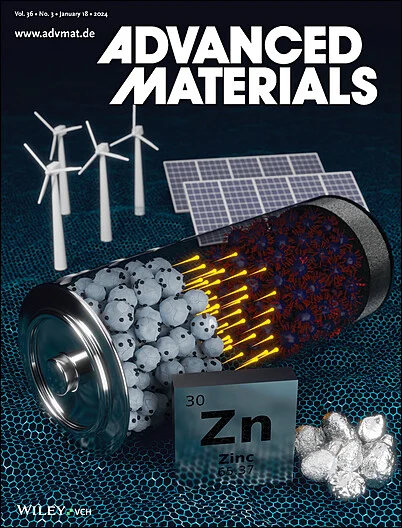通过分子链穿插实现离子导体与电子导体的高界面兼容性,从而实现可拉伸离子设备
IF 27.4
1区 材料科学
Q1 CHEMISTRY, MULTIDISCIPLINARY
引用次数: 0
摘要
本文章由计算机程序翻译,如有差异,请以英文原文为准。

Molecular Chain Interpenetration–Enabled High Interfacial Compatibility of Ionic and Electronic Conductors for Stretchable Ionic Devices
Ionic devices find applications such as flexible electronics and biomedicines and function by exploiting hybrid circuits of mobile ions and electrons. However, the poor interfacial compatibility of hard electronic conductors with soft ionic conductors in ionic devices leads to low deformability, sensitivity, electromechanical responses, and stability. Herein, an interpenetrating interface between silicone-modified polyurethane/carbon nanotube electronic conductors and ionoelastomers in an ionic device using in situ polymerization is fabricated. A robust interpenetrating electronic/ionic conductor interface is realized through molecular chain entanglement and molecular forces (such as ion-dipole interactions and H-bonds), effectively enhancing the bonding strength and contact area between the components and resulting in an excellent flexibility, stability, and device performance. The electroadhesive prepared based on this strategy exhibits a superrobust shear strength of 317 kPa under a reduced voltage input of −4 V, and the diode and the transistor can undergo arbitrary deformation while maintaining the semiconductor device characteristics, including rectification and switching. In addition, electromechanical transducers exhibit sensitive electrical responses to various deformation signals. This solution to the interfacial compatibility problems of electronic and ionic conductors holds promise for the development of multifunctional ionic devices.
求助全文
通过发布文献求助,成功后即可免费获取论文全文。
去求助
来源期刊

Advanced Materials
工程技术-材料科学:综合
CiteScore
43.00
自引率
4.10%
发文量
2182
审稿时长
2 months
期刊介绍:
Advanced Materials, one of the world's most prestigious journals and the foundation of the Advanced portfolio, is the home of choice for best-in-class materials science for more than 30 years. Following this fast-growing and interdisciplinary field, we are considering and publishing the most important discoveries on any and all materials from materials scientists, chemists, physicists, engineers as well as health and life scientists and bringing you the latest results and trends in modern materials-related research every week.
 求助内容:
求助内容: 应助结果提醒方式:
应助结果提醒方式:


